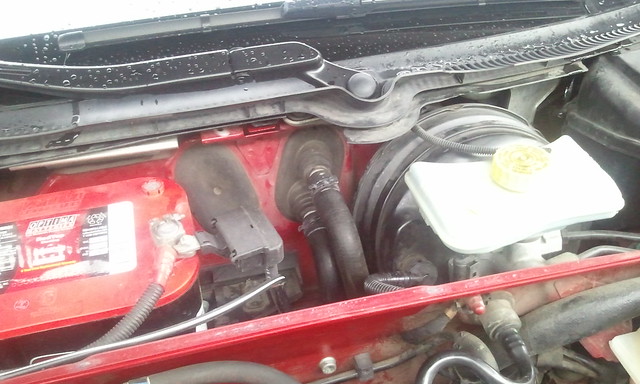Now that it is getting colder I noticed that my heater wasn't working very well. The problem was being caused by a large air bubble somewhere in the heater circuit. I know when the bubble was created. Back in September the clip holding the rear CTS cracked and consequently the sensor blew out of the motor. At that time I had a difficult time getting all the air out. Apparently I never got it all out.
Here's any easy way to tell if you have air trapped somewhere. Get your motor up to temperature. Then SLOWLY crack open the reservoir cap. If you have an air entrapment you should be able to hear the coolant gurgling and the coolant level in the reservoir will noticeably increase as the entrapped air is allowed to expand. The bigger the bubble the more the tank level will increase. If the bubble is big enough it will push coolant out of the overflow port on the bottom of the reservoir so be careful that you don't burn yourself. Even if you don't have any entrapped air the level will rise just a little as the coolant hoses contract back from the pressure release. However, you probably won't hear the gurgling noise that accompanies the bubble as it expands.
Now that you have the cap off you can release some of the air by cracking opening the bleeder valve in the center of the upper coolant hard pipe. Open it just enough for the air to escape. As soon as you get a solid stream of coolant close it off. You may have to repeat this process numerous times before you manage to work all the air out. The reservoir cap needs to be off when you perform this procedure so the static pressure in the reservoir will act on the hard pipe and push out the air. I just kept a 5mm Allen wrench in the car and a wad of paper towels stuck under the hood. whenever I took a short trip I just popped open the hood, shoved the wad of paper towels underneath the hard pipe and used this procedure to bleed the air off.
Unfortunately in my case this didn't release all the air so I had to take more extreme measures. Apparently I had a large bubble located in the heater core that wasn't bubbling out. After releasing all the system pressure I reinstalled the reservoir cap and then separated the quick connect on the out-feed side of the heater core. If you unscrew the coolant reservoir you can move it out of the way for easy access to the quick connect. I had a plug ready to block off the lower coolant line when I opened the quick connect. I used a long necked funnel to pour coolant directly into the heater core via the out-feed line. I then reattached the quick connect. After I did this I had to repeat the bleeding procedure outlined above three or four more times to get the rest of the air out.
I now have heat!













 Reply With Quote
Reply With Quote




 Do you know how and with what i can use to cold pressure test the system?
Do you know how and with what i can use to cold pressure test the system?




 [/IMG]
[/IMG]  [/IMG]
[/IMG]



Bookmarks